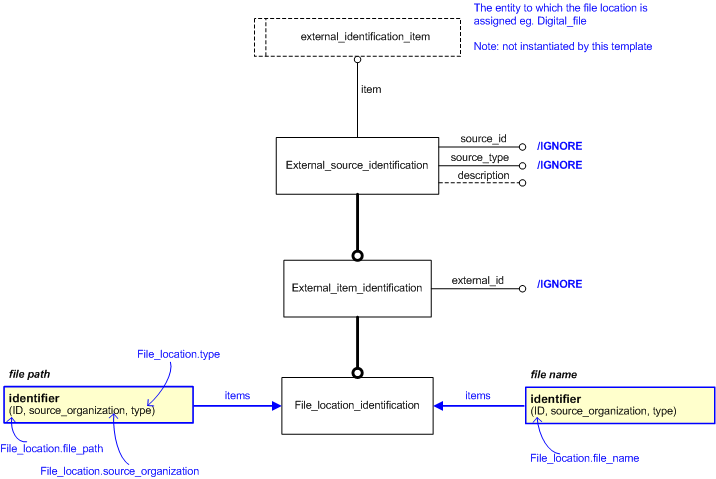Template:— file_location (file_locn)
Context:— UK_Defence |
Date: 2009/04/17 11:50:09
Revision: 1.2
|
This section specifies the template file_location.
NOTE
The template has been defined in the context of
UK_Defence.
Refer to the business context for details of related templates.
NOTE
An explanation of a template and the associated instantiation path is
provided in the
Template overview
section.
This template describes how to represent a file location.
The EXPRESS-G diagram in
Figure
1
shows the templates and EXPRESS entities that are required
to represent the template
"file_location".
The text highlighted in blue shows the template parameters.
Figure 1 — An EXPRESS-G representation of the Information model for file_location
The graphic for the template to be used in other EXPRESS-G diagrams
is shown in Figure
2
below.
Figure 2 — The graphical representation of the file_location template
The following input parameters are defined for this template:
The location of the file.
The type of file location eg. URL or FTP.
The following classes and their sub-classes can be used:
classifications: [File_location_identification_type]![[warning:]](../../../../../../images/dex/warning.gif) Error RDL4: The URI urn:plcs:rdl:uk_defence is not listed in dexlib/data/refdata/rdl_index.xml
Error RDL4: The URI urn:plcs:rdl:uk_defence is not listed in dexlib/data/refdata/rdl_index.xml
The source organization of the file location.
The item to which the location refers.
The following reference parameters are defined for this template:
Allow the
External_class
entity instantiated in this path to be referenced when this template is used.
Note: The
External_class
entity can be referenced in a template path by:
%^target = $file_location.ext_class%
The instantiation path shown below specifies the entities that are to be
instantiated by the template.
A description of templates and the syntax for the instantiation path is
provided in the
Templates Help/Information section.
The following entities are instantiated with attributes as specified:
The instance diagram in Figure
3
shows an example of the EXPRESS entities and templates that are instantiated by the template:
/file_location(file_path='', type='', source_organization='', file_name='', item='')/
(an illustration of the consolidated file_location template is shown in
Figure
4 below.)
Figure 3 — Entities instantiated by file_location template
The instance diagram in
Figure
4
shows the graphic symbol for the template that is to be
used in other instance diagrams. The example template is:
/file_location(file_path='', type='', source_organization='', file_name='', item='')/
Figure 4 — Instantiation of file_location template
Characterizations
No common characterizations of the template
file_location
have been identified. However, the ISO 10303-239 EXPRESS model
may enable other assignments to the entities instantiated by the template.




